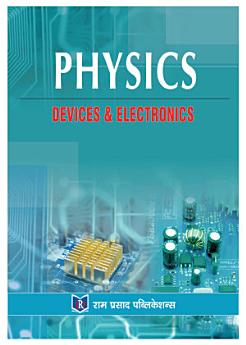PHYSICS: DEVICES & ELECTRONICS
About this ebook
Semiconductor; Intrinsic and Extrinsic Semiconductors; Electrical Properties of Semiconductor; P-N Junction Diode (Semiconductor Diode); Expression for Width of Depletion Layer and Potential Barrier; Biasing of a P-N Junction; V-I Characteristics of a P-N Junction; Important Terms used in P-N Junction; Avalanche and Zener Breakdown; Ideal Diode; Point-Contact Diode; Zener Diode; Varactor or Varicap Diode; Tunnel Diode; Photo-Diode; Light Emitting Diode (LED); Schottky Diode; Liquid Crystal Displays (LCD); Solar Cell (Solar Photo Vottaic Cell); Junction Transfer (Bipolar Junction Transistor); Transistor Terminals; Transistor Action; Transistor Symbols; Operating Conditions of a Transistor; Rectification; Half Wave Rectifier; Full Wave Rectifier; Power Supply; Regulated Power Supply; Integrated Circuits (ICS).
2. Transistors
Transistor Connections; Early Effect or Base Width Modulation; Commonly used Transistor Connection; Transistor as an Amplifier in C-E Arrangement; Field Effect Transistor; Difference between FET and BJT; Junction Field Effect Transistor; Characteristics of JFET; Applications of FET; Parameters of FET; Expression for Pinch-off Voltage; Advantages and Disadvantages of FET; Metal Oxide Semiconductor Field Effect Transistor; Depletion Type MOSFET; Static Characteristics of Depletion MOSFET; The Enhancement MOSFET; Characteristics of Enhancement MOSFET; Advantages and Applications of MOSFET; Comparison of N-Channel with P-Channel JFETs; Comparison of N-Channel with P-Channel MOSFETs; Unijunction Transistor (UJT); Equivalent Circuit of a UJT; Characteristics of UJT; Advantages of UJT; Applications of UJT; Hybrid Parameters; Transistor Biasing; Transistor Load Line; Stabilisation; Stability Factor; Methods of Transistor Biasing; Transistor Amplifier and Classification; Common Emitter Transistor Amplifier; Common Base Transistor Amplifier; Hybrid Equivalent Circuit of Common Emitter Amplifier; Conversion of h-Parameters; JFET Biasing; MOSFET Biasing.
3. Amplifier-I
Transistor Amplifier and Classification; Common Emitter Transistor Amplifier; Common Base Transistor Amplifier; R-C Coupled Amplifier; Distortion; Frequency Response; Decibel Gain; Band-Width (B.W.); Simplified Hybrid Equivalent Circuits of R-C Coupled Amplifier; Multistage Transistor Amplifiers.
4. Amplifier-II
Transformer-Coupled (T-C) Amplifier; FET Amplifier (Common Source); Noise in Electric Circuits; Common Drain Amplifier; Emitter Follower.
5. Feedback Amplifiers and Oscillators
Feedback and Feedback Amplifier; Principle of Feedback; Advantages of Negative Feedback; Negative Feedback Circuits; Oscillator and Classification; Essentials of Transistor Oscillator; Barkhausen Criterion for Oscillations (Condition for Self-excitation); Wien Bridge Oscillator; Hartley Oscillator; Colpitt’s Oscillator.








